
Spiranthes spiralis, commonly known as autumn lady's-tresses, is an orchid that grows in Europe and adjacent North Africa and Asia. It is a small grey-green plant. It forms a rosette of four to five pointed, sessile, ovate leaves about 3 cm (1.2 in) in length. In late summer an unbranched stem of about 10–15 cm (3.9–5.9 in) tall is produced with approximately four sheath-shaped leaves. The white flowers are about 5 mm (0.20 in) long and have a green spot on the lower lip. They are arranged in a helix around the upper half of the stalk. The species is listed in Appendix II of CITES as a species that is not currently threatened with extinction but that may become so. Autumn lady's-tresses are legally protected in Belgium and the Netherlands.
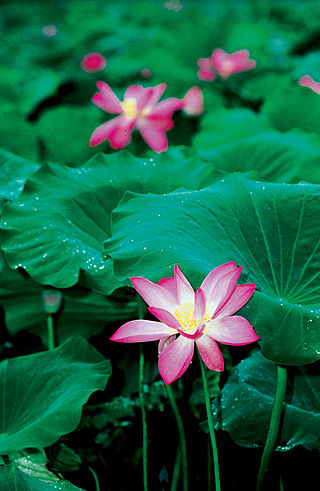
This is a list of plants commonly found in Kakadu National Park, Northern Territory of Australia. Where known, common names are given in English and in Gun-djeihmi, a commonly spoken indigenous language in the area, are given in parentheses.
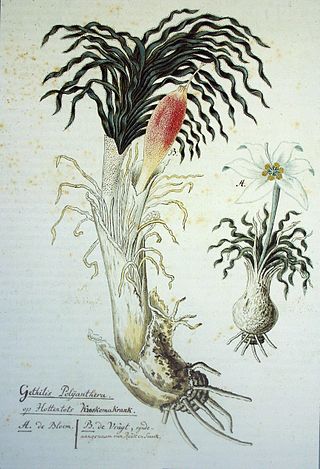
Gethyllis, commonly called Kukumakranka, Koekemakranka, or Kroekemakrank, is a genus of bulbous plant in the Amaryllid family with some 33 accepted species. It is native to the Cape Provinces, the Northern Provinces and the Free State of South Africa, as well as Botswana and Namibia.

Strumaria is a genus of African plants in Amaryllis family, subfamily Amaryllidoideae. The genus is known in nature only from South Africa, Lesotho and Namibia. Almost all species flower in the autumn and are cultivated as ornamental bulbous plants.

Albuca bracteata, is known by the common names pregnant onion, false sea onion, and sea-onion. It is a species of bulbous flowering plant in the family Asparagaceae. Its flowering stems can reach a height of 90 cm and can carry up to 100 greenish white flowers.

Albuca is a genus of flowering plants in the family Asparagaceae, subfamily Scilloideae. The genus is distributed mainly in southern and eastern Africa, with some species occurring in northern Africa and the Arabian Peninsula. Plants of the genus are known commonly as slime lilies.

Dittrichia viscosa, also known as false yellowhead, woody fleabane, sticky fleabane and yellow fleabane, is a flowering plant in the daisy family.

Eucomis zambesiaca is a bulbous plant in the family Asparagaceae, subfamily Scilloideae, native to southern Africa, from Zimbabwe through Malawi to the Limpopo Province of South Africa. One of the smaller species in the genus, it has a rosette of leaves about 45 cm (18 in) across and white flowers in a spike to about 30 cm (12 in) tall.

Astroloba spiralis is a small succulent plant of the Astroloba genus, endemic to the southern Karoo regions of the Western and Eastern Cape Provinces, South Africa.
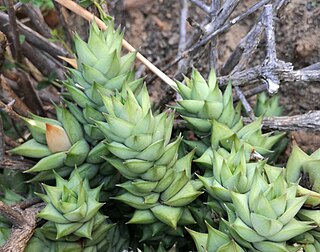
Astroloba herrei is a small succulent plant of the genus Astroloba, restricted to the area around the Swartberg mountains, South Africa.

Albuca humilis is a bulbous flowering plant, placed in the genus Albuca in the subfamily Scilloideae of the family Asparagaceae. It is native to southern Africa – to South Africa from the Free State to KwaZulu-Natal according to some sources, or to the Drakensberg Mountains of Lesotho according to others.

Beyeria viscosa, commonly known as the pinkwood or sticky wallaby bush, is a species of flowering plant in the spurge family, Euphorbiaceae, that is endemic to Australia.

Albuca shawii is a species of bulbous plant from southern Africa. It flowers in the summer and has yellow flowers on stems to about 30 cm high.
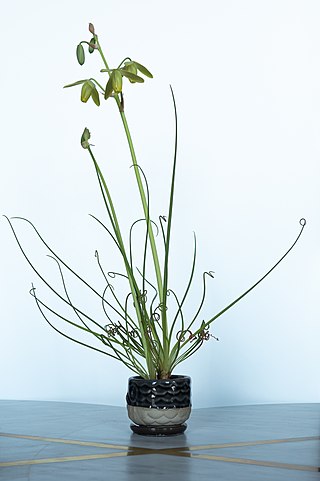
Albuca spiralis, commonly called the corkscrew albuca or frizzle sizzle, is a species of flowering plant in the family Asparagaceae, that is native to Western and Northern Cape Provinces, South Africa.
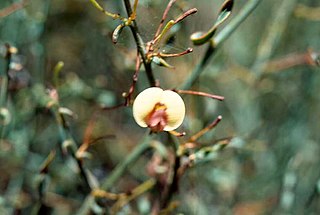
Daviesia spiralis, commonly known as spiral-leaved daviesia, is a species of flowering plant in the family Fabaceae and is endemic to a restricted area of south-western Western Australia. It is a rounded shrub with tangled branches, scattered, twisted linear phyllodes and yellow and red flowers.

Albuca juncifolia is a bulbous flowering plant, placed in the genus Albuca in the subfamily Scilloideae of the family Asparagaceae.
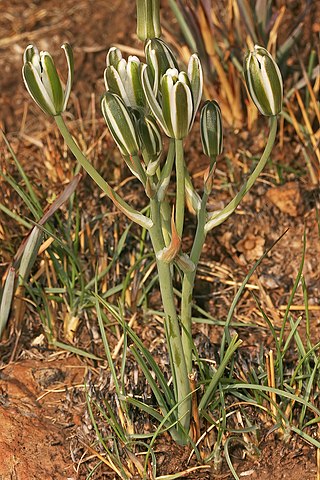
Albuca setosa is a species of small, perennial, bulbous plant in the asparagus family. It is native to the Cape Provinces and KwaZulu-Natal in South Africa.

Albuca cooperi is a species of small, perennial, bulbous plant in the asparagus family.

Albuca acuminata is a species of small, perennial, bulbous plant in the asparagus family. It is native to southern Africa from Namibia to the Cape Province of South Africa, where it occurs in rocky areas, as far east as Port Alfred.
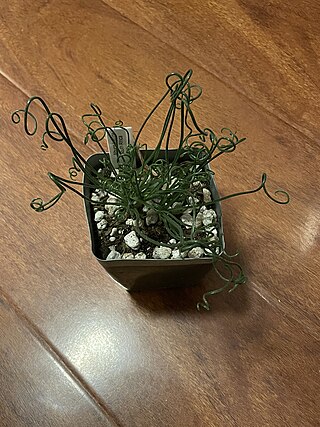
Albuca foetida is a species of slime lily native to Namaqualand in South Africa first described in 1996 in Feddes Repertorium.





















